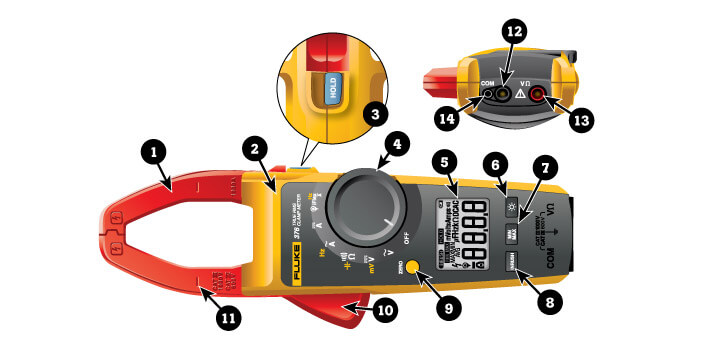A clamp meter is an electrical test tool that combines a basic digital multimeter with a current sensor.
Clamps measure current. Probes measure voltage. Having a hinged jaw integrated into an electrical meter allows technicians to clamp the jaws around a wire, cable or other conductor at any point in an electrical system, then measure current in that circuit without disconnecting/deenergizing it.
Beneath their plastic moldings, hard jaws consist of ferrite iron and are engineered to detect, concentrate and measure the magnetic field being generated by current as it flows through a conductor.
The diagram above identifies basic functions are:

- Current-sensing jaw.
- Tactile barrier (to protect fingers from shocks).
- Hold button: Freezes the display reading. Reading is released when button is pushed a second time.
- Dial (aka rotary switch).
- Display.
- Backlight button.
- Min Max button: On first push, display shows maximum input. On subsequent pushes, minimum and average inputs are shown. Works in current, voltage and frequency modes.
- Inrush current button.
- Zero button (yellow): Removes dc offset from dc current measurements. Also serves as dial’s shift button to select yellow functions scattered around the dial.
- Jaw release lever.
- Alignment marks: To meet accuracy specifications, a conductor must be aligned with these marks.
- Common input jack.
- Volts/ohm input jack.
- Input for flexible current probe.
Originally created as a single-purpose test tool, modern clamp meters offer more measurement functions, greater accuracy and in some cases specialized measurement features. Today’s clamp meters include most of the basic functions of a digital multimeter (DMM), such as the ability to measure voltage, continuity and resistance.
Clamp meters have become popular tools primarily for two reasons:
- Safety. Clamp meters allow electricians to bypass the old-school method of cutting into a wire and inserting a meter’s test leads into the circuit to take an in-line current measurement. The jaws of a clamp meter do not need to touch a conductor during a measurement.
- Convenience. During a measurement, it is not necessary to shut off the circuit carrying current—a big boost in efficiency.
Clamp meters are preferred for measuring high levels of current. DMMs cannot measure 10 A of current for more than 30 seconds without risking damage to the meter.
Clamp meters offer a minimum current range of 0 A to 100 A. Many models have a range up to 600 A. Others go up to 999 A or 1400 A, and some plug-in clamp accessories such as the iFlex® can measure as high as 2500 A.
Clamp meters are used on industrial equipment, industrial controls, residential/commercial/industrial electrical systems, and commercial/industrial HVAC. They are primarily used for:
- Service: To repair existing systems on an as-needed basis.
- Installation: To troubleshoot installation problems, perform final circuit tests, and supervise apprentice electricians while installing electrical equipment.
- Maintenance: To perform scheduled and preventative maintenance as well as system troubleshooting.
Three types of clamp meters exist:
- Current transformer clamp meters: measure only alternating current (ac).
- Hall Effect clamp meters: measure both alternating current and direct current (ac and dc).
- Flexible clamp meters: employ a Rogowski coil; measure ac only; good for measuring in tight spaces.
While different, they share the same fundamental methodology when making measurements: A conductor is passed through a probe (either the hard jaws built into a clamp meter, or the flexible coil of a clamp accessory), and the vector sum of the currents flowing through the conductor is calculated by the meter.
Source : Fluke
Good explanation.